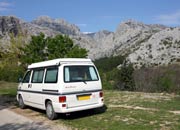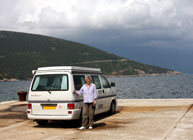|
Roads
and driving standards: despite the
macho Balkan image of Croatians, driving standards are no
worse than elsewhere, and certainly better than Greece!
Road conditions are generally good on main roads, but inland
on minor roads, re-surfacing work or road widening may
result in sometimes long stretches of unsurfaced road. The
main highway down the whole length of the Adriatic coast,
the Jadranska Magistrala (Adriatic Highway or Magistrala)
has progressively been improved and, although only single
carriage-way, is now a good road for most of its length.
Motorways:
despite the hostile terrain, the Croatian motorway (autocesta)
network is of high standard and increasing. Motorways are
commercially operated and tolls are quite expensive:
A1:
currently extends south from Zagreb to just beyond Split and
is planned to reach Dubrovnik
later in 2008
A3 runs from the Slovene border past Zagreb and out to the Serbian
border at Lipovac
A4 runs north from Zagreb up to the Hungarian border beyond Čakovec
A6 runs west from Zagreb to Rijeka; although still partially under
construction, all tunnels are complete
A7 runs north from Rijeka up to the Slovene border at Rupa
The web
site of the Croatian Motorways Agency (Hrvatske autoceste)
is tediously slow and difficult to navigate, but with perseverance, you may get useful information about motorway conditions and
progress with
development:
 Croatian Motorways Agency web site Croatian Motorways Agency web site
Fuel:
fuel is readily available across the country and
credit cards are accepted at garages. Fuel prices are no
cheaper than most of continental Europe.
Speed
limits: within built-up areas:
50 kph (30 mph)
open road: 80 kph (50 mph)
} The distinction is ambiguous -
highways: 90 kph (60 mph)
} watch the speed limit signs
motorways: 110-130 kph (70-80 mph) - watch the signs
Croat
drivers seem to believe they enjoy immunity to drive at whatever crazy
speeds they like; under NO circumstances does
this freedom apply to you. Croatian police are rumoured to
target foreign registered cars and on-the-spot fines for
speeding are hefty. So observe speed limits punctiliously!
Driving
regulations: Croatia has a zero
alcohol policy for drivers, and penalties for
offenders are SEVERE.
Dipped headlights are compulsory at all times, regardless of
weather conditions with on-the-spot fines for driving
without lights.
Insurance
and the notorious Neum corridor: check before you leave
that your vehicle insurance, and recovery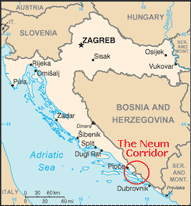 service, cover you
for Croatia; there are still unbelievably some backwoodsmen
UK insurers that don't. But it is unlikely that your insurer
will cover you for Bosnia-Hercegovina (BiH), and if you plan
to drive the full length of the Magistrala down to
Dubrovnik, you have a potential problem: the so-called Neum
corridor refers to a 10 km wide strip of Bosnian territory
which gives BiH access to the Adriatic at the grubby coastal
resort of Neum, and which you have to drive through to reach
southern Croatia. Despite the official advice given by the
UK Foreign and Commonwealth Office, even the Croatian and
Bosnian embassies in London insist that this strip is open
space between the separate parts of Croatia, and that a
'green card' is unnecessary if your insurance covers Croatia. The alternative is to cross
by ferry to the Peljeac peninsula which re-joins the
Croatian mainland further south, a pleasant enough drive but
more expensive and a long tortuous and mountainous route. If you
take the risk and drive through the corridor, Bosnian
driving standards are less forgiving and technically you
would be uninsured without a 'green card'. It's really up to you. If you want to know what
we did, click here service, cover you
for Croatia; there are still unbelievably some backwoodsmen
UK insurers that don't. But it is unlikely that your insurer
will cover you for Bosnia-Hercegovina (BiH), and if you plan
to drive the full length of the Magistrala down to
Dubrovnik, you have a potential problem: the so-called Neum
corridor refers to a 10 km wide strip of Bosnian territory
which gives BiH access to the Adriatic at the grubby coastal
resort of Neum, and which you have to drive through to reach
southern Croatia. Despite the official advice given by the
UK Foreign and Commonwealth Office, even the Croatian and
Bosnian embassies in London insist that this strip is open
space between the separate parts of Croatia, and that a
'green card' is unnecessary if your insurance covers Croatia. The alternative is to cross
by ferry to the Peljeac peninsula which re-joins the
Croatian mainland further south, a pleasant enough drive but
more expensive and a long tortuous and mountainous route. If you
take the risk and drive through the corridor, Bosnian
driving standards are less forgiving and technically you
would be uninsured without a 'green card'. It's really up to you. If you want to know what
we did, click here
Ferries and
island hopping: part of the fun of travelling down
the Dalmatian archipelago is exploring the many islands of
this fascinating coastline, using the extensive ferry
services operated mainly by the Jadrolinija Ferry Company.
Crossings are not unduly expensive,
almost all the ferries are drive-on/drive-off, and
you buy tickets at the port of embarkation, usually 10
minutes before sailing times. Visit the Jadrolinija
web site, and click on the sailings
schedules interactive maps:
Company.
Crossings are not unduly expensive,
almost all the ferries are drive-on/drive-off, and
you buy tickets at the port of embarkation, usually 10
minutes before sailing times. Visit the Jadrolinija
web site, and click on the sailings
schedules interactive maps:
 Jadrolinija ferry services Jadrolinija ferry services
|
 Konzum supermarket chain has shops in most towns
and cities around the country. Similarly you
will find a number of supermarkets operated
by the Slovenian Mercator company and by the
Austrian Billa chain. All offer good choice
and value.
Konzum supermarket chain has shops in most towns
and cities around the country. Similarly you
will find a number of supermarkets operated
by the Slovenian Mercator company and by the
Austrian Billa chain. All offer good choice
and value.
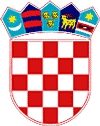
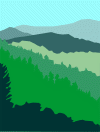

 UK
passport-holders may visit Croatia for up to 3 months
without a visa, and drive for up to 6 months with a standard UK-EU driving
licence. Carry your passport at all times as identification.
All visitors are required by law to register with the local
police within 24 hours of arrival; campsites will do this
for you but sometimes add a small charge
UK
passport-holders may visit Croatia for up to 3 months
without a visa, and drive for up to 6 months with a standard UK-EU driving
licence. Carry your passport at all times as identification.
All visitors are required by law to register with the local
police within 24 hours of arrival; campsites will do this
for you but sometimes add a small charge Britain
has a reciprocal health care arrangement with Croatia, where
no charge is made for emergency treatment. But only basic
care may be available in rural areas; make sure you have comprehensive
travel insurance, and carry your European Health Insurance
Card (even though Croatia is not yet in the EU). Immunisation
against tick-born encephalitis which is endemic in inland
Croatia is recommended.
Britain
has a reciprocal health care arrangement with Croatia, where
no charge is made for emergency treatment. But only basic
care may be available in rural areas; make sure you have comprehensive
travel insurance, and carry your European Health Insurance
Card (even though Croatia is not yet in the EU). Immunisation
against tick-born encephalitis which is endemic in inland
Croatia is recommended.


 The Camping Card
International (CCI - Camping Carnet) is a worthwhile small
investment; it only costs £4.75, lasts for a year
and can be bought
through Camping Organisations eg
The Camping Card
International (CCI - Camping Carnet) is a worthwhile small
investment; it only costs £4.75, lasts for a year
and can be bought
through Camping Organisations eg  Camping
Gaz is simply unavailable in Croatia; we failed to find even
any semi-legitimate sources of re-filling empty 907 cylinders. So
make sure you take a good stock of gas with you.
Camping
Gaz is simply unavailable in Croatia; we failed to find even
any semi-legitimate sources of re-filling empty 907 cylinders. So
make sure you take a good stock of gas with you. Very few Croatian campsites yet have
wi-fi internet hotspots (identified in the
Very few Croatian campsites yet have
wi-fi internet hotspots (identified in the



 The Fall of Yugoslavia: Misha
Glenny, 3rd edition 1996
The Fall of Yugoslavia: Misha
Glenny, 3rd edition 1996
 For
planning and general
use, the most useful and durable overall map of Croatia is
that published by Rough Guides 1:325k scale (see left) price £5.99;
details on The Map Shop web site. But in an attempt to fit
Croatia's peculiar shape onto the two sides of the map, the
cartographers have had to turn the projections 45° out of
the conventional alignment; north is no longer where
familiarity dictates it should be, and the Dalmatian coast
seems to run west-east rather than NW-SE. It takes some
getting used to!
For
planning and general
use, the most useful and durable overall map of Croatia is
that published by Rough Guides 1:325k scale (see left) price £5.99;
details on The Map Shop web site. But in an attempt to fit
Croatia's peculiar shape onto the two sides of the map, the
cartographers have had to turn the projections 45° out of
the conventional alignment; north is no longer where
familiarity dictates it should be, and the Dalmatian coast
seems to run west-east rather than NW-SE. It takes some
getting used to!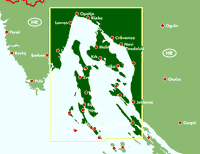
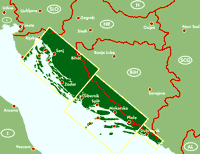 For
detailed maps of the Dalmatian coast and islands at 1:100k
scale, we recommend the series of 6 maps published by
Freytag and Berndt, covering Istria, the Islands of Cres and
Krk and Kvarner coast, and the middle and southern Dalmatian
coast. These do show campsite with reasonable accuracy.
For
detailed maps of the Dalmatian coast and islands at 1:100k
scale, we recommend the series of 6 maps published by
Freytag and Berndt, covering Istria, the Islands of Cres and
Krk and Kvarner coast, and the middle and southern Dalmatian
coast. These do show campsite with reasonable accuracy.


 service, cover you
for Croatia; there are still unbelievably some backwoodsmen
UK insurers that don't. But it is unlikely that your insurer
will cover you for Bosnia-Hercegovina (BiH), and if you plan
to drive the full length of the Magistrala down to
Dubrovnik, you have a potential problem: the so-called Neum
corridor refers to a 10 km wide strip of Bosnian territory
which gives BiH access to the Adriatic at the grubby coastal
resort of Neum, and which you have to drive through to reach
southern Croatia. Despite the official advice given by the
UK Foreign and Commonwealth Office, even the Croatian and
Bosnian embassies in London insist that this strip is open
space between the separate parts of Croatia, and that a
'green card' is unnecessary if your insurance covers Croatia. The alternative is to cross
by ferry to the Peljeac peninsula which re-joins the
Croatian mainland further south, a pleasant enough drive but
more expensive and a long tortuous and mountainous route. If you
take the risk and drive through the corridor, Bosnian
driving standards are less forgiving and technically you
would be uninsured without a 'green card'. It's really up to you. If you want to know what
we did,
service, cover you
for Croatia; there are still unbelievably some backwoodsmen
UK insurers that don't. But it is unlikely that your insurer
will cover you for Bosnia-Hercegovina (BiH), and if you plan
to drive the full length of the Magistrala down to
Dubrovnik, you have a potential problem: the so-called Neum
corridor refers to a 10 km wide strip of Bosnian territory
which gives BiH access to the Adriatic at the grubby coastal
resort of Neum, and which you have to drive through to reach
southern Croatia. Despite the official advice given by the
UK Foreign and Commonwealth Office, even the Croatian and
Bosnian embassies in London insist that this strip is open
space between the separate parts of Croatia, and that a
'green card' is unnecessary if your insurance covers Croatia. The alternative is to cross
by ferry to the Peljeac peninsula which re-joins the
Croatian mainland further south, a pleasant enough drive but
more expensive and a long tortuous and mountainous route. If you
take the risk and drive through the corridor, Bosnian
driving standards are less forgiving and technically you
would be uninsured without a 'green card'. It's really up to you. If you want to know what
we did,  Company.
Crossings are not unduly expensive,
almost all the ferries are drive-on/drive-off, and
you buy tickets at the port of embarkation, usually 10
minutes before sailing times. Visit the Jadrolinija
web site, and click on the sailings
schedules interactive maps:
Company.
Crossings are not unduly expensive,
almost all the ferries are drive-on/drive-off, and
you buy tickets at the port of embarkation, usually 10
minutes before sailing times. Visit the Jadrolinija
web site, and click on the sailings
schedules interactive maps: